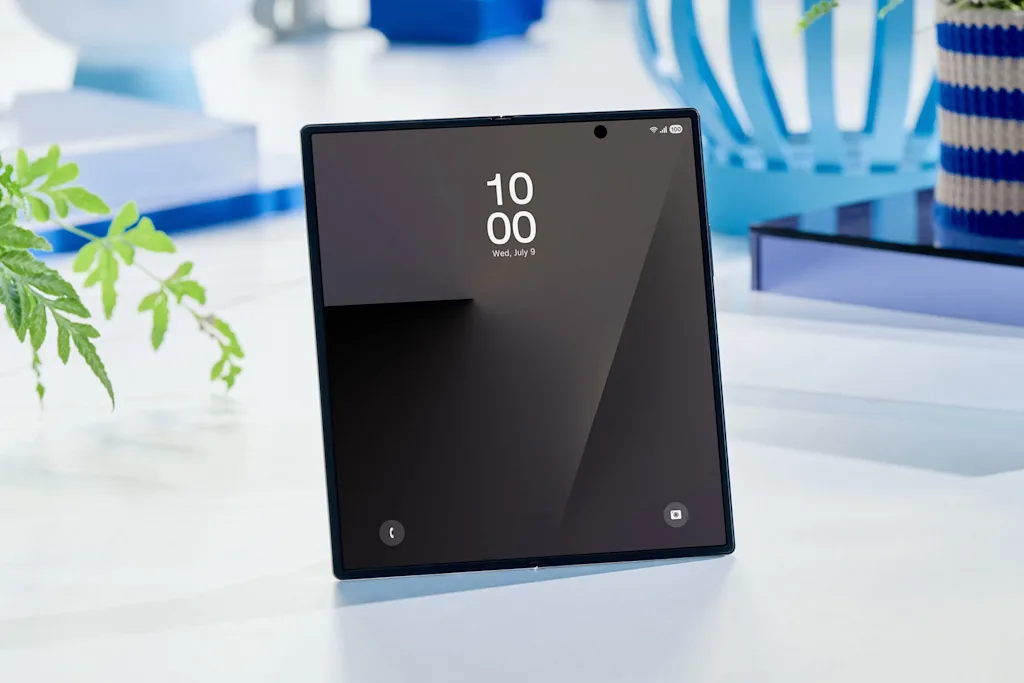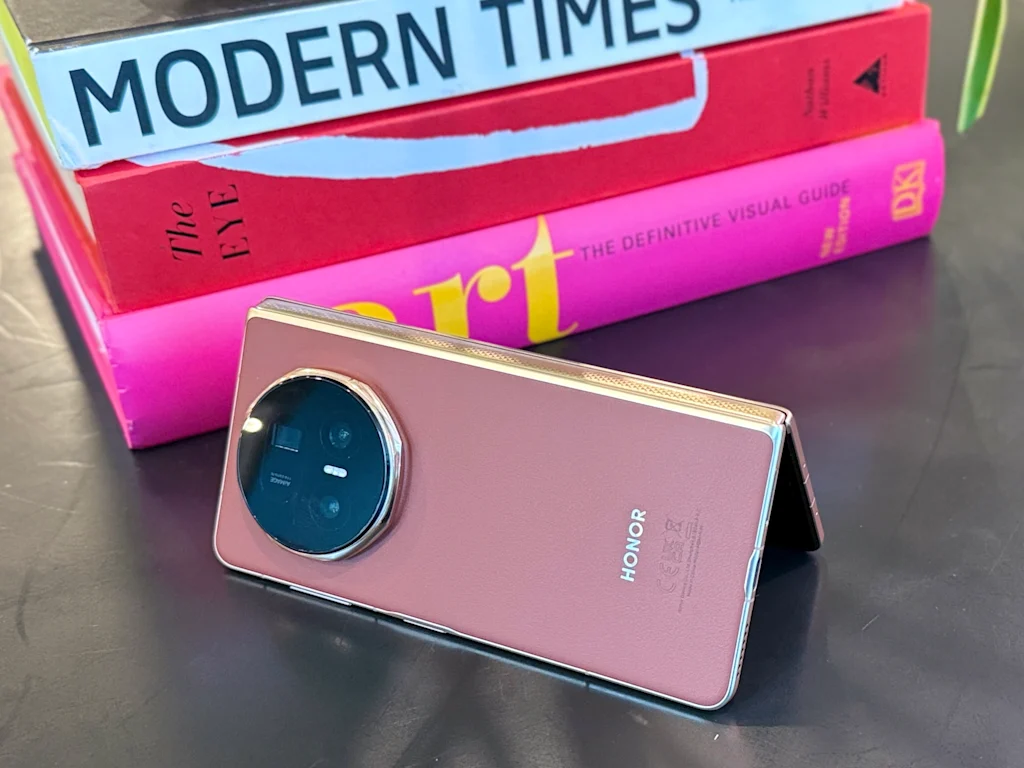Hello once again and thanks for spending time with Fast Company’s Plugged In.
Fifteen years into the era defined by the iPhone, a question still looms over the consumer tech industry: What’s the next great personal computing device after the smartphone?
The brave new ideas keep on coming. A few have succeeded—but as phone accessories, not replacements. Others remain works in progress. Some have already failed in spectacular fashion.
But one emerging device category has been easy to gloss over: the folding phone. No, it doesn’t represent a bold gambit to kill the smartphone. It is a smartphone! However, by squeezing the equivalent of a tablet into pocketable form, it also departs radically from the Hershey Bar-shaped touchscreen gadget that Apple pioneered and the rest of the industry cloned as fast as it could.
After six years on the market, foldable smartphones reportedly account for only 1.5% of smartphones sold. At least in part, that’s because they’ve had a whole flock of albatrosses around their neck. Figuring out how to design ones that are inviting to use when they’re folded up—and twice as thick as when unfolded—has been a challenge. They’ve often been outfitted with less-than-stellar cameras and other sub-flagship components. Hinge robustness and general durability have been open to questions. And all of that’s before you get to their price tags, which started at $1,980 with Samsung’s original Galaxy Fold and hover in the same imposing vicinity today.
Recently, though, foldables seem to be hitting their stride. My colleague Jared Newman was wowed by Samsung’s latest model, the Galaxy Z Fold7. Google’s Pixel 10 Pro Fold, shipping next month, is the first foldable to achieve IP68 water and dust resistance. Bloomberg’s Mark Gurman says the first foldable iPhone is a go for 2026—evidence that Apple believes the category is real rather than a fad to be ignored.

And then there’s Honor’s Magic V5, the newest foldable from one of China’s major phone makers. Though not for sale in the U.S., it recently debuted in Europe, claiming bragging rights as the world’s thinnest folding phone. That’s only so heady an achievement: It applies to only one color variant (Ivory White), involves beating the Fold7 by just .1 millimeter, and doesn’t count the bulbous camera bump, which protrudes from the back of the V5 like a spare tire mounted on a Jeep.
Still, after spending a week or so with a review unit provided by Honor, I’m impressed. The price remains steep: In Europe, the phone sells for 1,999 euros (about $2,300). But Honor has overcome many design challenges once inherent to the foldable category. It also has a competitive advantage in its use of silicon carbide battery technology, which allows it to pack more battery density into the phone’s slender frame—short running time being yet another hobgoblin faced by past foldables. In my experience, even using the phone with abandon over the course of a day didn’t drain its battery to anywhere near zero.
Closed, the Magic V5 is a very pleasant Android phone. It runs Honor’s MagicOS 9, a reskinned version of Android 15 bearing so close a resemblance to iOS that my fingers forgot they weren’t maneuvering around an iPhone. I thought the brown vegan leather back on the review unit would come off as tacky, but its aesthetics and comfort quickly won me over. Even sheathed in the bundled case—also in brown vegan leather—the phone doesn’t feel any bulkier in my hand than my own cased iPhone 16 Pro.

I was also prepared for the Magic V5’s cameras to be letdowns, like those on some of the foldables I’ve tried in the past. Instead, the snapshots I took with its rear-facing cameras—ultrawide, wide, and 3X telephone—were in the same image-quality ballpark as those from my iPhone.
Unfolded, the Magic V5 really does feel more like a tablet than a phone. The 7.9-inch screen is smaller than an iPad Mini, but it’s a boon to any task that feels cramped on a garden-variety phone, from watching movies to reading books to wrangling spreadsheets. Honor’s multitasking interface makes it easy to have multiple apps on-screen at once: side by side or with some floating in windows. The phone also includes a profusion of bundled Honor apps—such as a calendar, notetaker, and photo gallery—that smartly fill all that real estate with sidebars and other elements that wouldn’t fit on a standard phone screen.
Many of the third-party apps I tried did leave me vaguely unsatisfied, though. Only rarely did I detect evidence they were aware they were operating on a larger, folding screen. Way back when Android tablets were first a thing, I groused that they ran smartphone apps that had been merely scaled up rather than reimagined. Today, folding phones suffer from a similar failure by developers to seize the opportunity before them—maybe because their user base remains dinky.
Which brings us to the folding iPhone that will theoretically arrive next year.
According to the rumor mill, that phone may reflect Apple’s efforts to address lingering folding-phone downsides, such as the obviousness of the crease down the middle of the unfolded screen. (It was readily apparent on the Magic V5, though I didn’t find it particularly aggravating even if I forced myself to obsess over it.) Apple could also bring some fresh thinking to the software side: Oddly enough, Split Screen and SlideOver—the iPad multitasking features abandoned in iPadOS 26—would serve as a solid foundation for a folding iPhone interface.
As for third-party software, anyone who’s already building both iPhone and iPad versions of an app has a head start on tailoring experiences to a variety of screen sizes. That might give a folding iPhone an edge on Android foldables, particularly if developers sense that the device is a hit and its users represent a growing percentage of their customers, even if it starts small.
Whether I’ll end up owning a folding phone myself, I’m still not sure. But seeing phone makers get serious about them has put me in piqued-interest mode. That’s progress in itself. It’s fun to wonder where foldables might be by the time I’m ready to talk myself into splurging on one.
You’ve been reading Plugged In, Fast Company’s weekly tech newsletter from me, global technology editor Harry McCracken. If a friend or colleague forwarded this edition to you—or if you’re reading it on FastCompany.com—you can check out previous issues and sign up to get it yourself every Friday morning. I love hearing from you: Ping me at hmccracken@fastcompany.com with your feedback and ideas for future newsletters. I’m also on Bluesky, Mastodon, and Threads, and you can follow Plugged In on Flipboard.
More top tech stories from Fast Company
Your phone’s ‘Share’ button doesn’t get enough love
Beyond just sharing links and photos with other people, it serves as a hub for all kinds of helpful shortcuts. Read More →
Perplexity’s new AI bet: Monetize the bots, pay the publishers
Perplexity’s new revenue model aims to pay publishers not just for page views—but for what its AI bots do with their content. Read More →
Kids aren’t reading for pleasure—and more than tech is to blame
Doomscrolling. Poor literacy instruction. Overscheduling. These are some of the reasons cited for a generational decline in students reading for fun. Read More →
The ‘cortisol cocktail’ is blowing up on TikTok. Does it really work?
TikTok users swear the nonalcoholic drink can lower stress hormones. Experts say the science isn’t nearly as clear. Read More →
Crypto.com bets big on sports prediction markets
In partnership with fantasy-sports app Underdog, the company is bringing prediction markets to 16 states, bypassing legal-betting roadblocks in places like California and Texas. Read More →
Starbucks’s new AI could save its baristas 16,500 hours a week
A new inventory system will save Starbucks a ridiculous amount of time counting pumpkin spice at scale. Read More →
Melden Sie sich an, um einen Kommentar hinzuzufügen
Andere Beiträge in dieser Gruppe

I was reading funding news last week, and I came to a big realization: Andreessen Horowitz is not a venture capital fund.
A lot of people are thinking it. So there, I said it.

A post circulating on Facebook shows a man named Henek, a violinist allegedly forced to play in the concentration camp’s orchestra at Auschwitz. “His role: to play music as fellow prisoners

In the first half of 2025, she racked up over 55 million views on TikTok and 4 mil

Apple’s annual iPhone event is happening next week, when the company is

What do a yoga instructor, a parking garage attendant, and an influencer have in common? They are all now exempt from paying income tax on their tips under President Donald Trump’s “Big Beautiful


TikTok gave us slang like rizz, while X popularized ratio and
